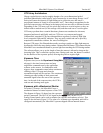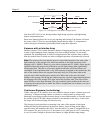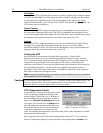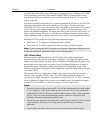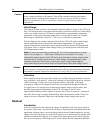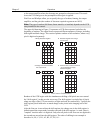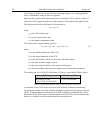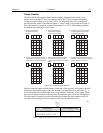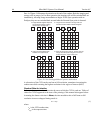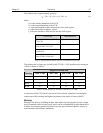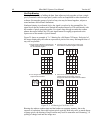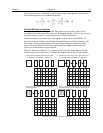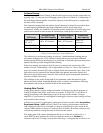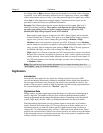
64 MicroMAX System User Manual Version 6.C
Interline
In this section, a simple 6 × 3 pixel interline CCD is used to demonstrate how charge is
shifted and digitized. As described below, two different types of readout, overlapped and
non-overlapped can occur. In overlapped operation, each exposure begins while the
readout of the previous one is still in progress. In non-overlapped operation (selected
automatically if the exposure time is shorter than the readout time) each readout goes to
completion before the next exposure begins.
Overlapped Operation Exposure and Readout
Figure 23 illustrates exposure and readout when operating in the overlapped m
ode.
Figure 23 contains four parts, each depicting a later stage in the exposure-readout cy
cle.
Eight columns of cells are shown. Columns 1, 3, and 5 contain imaging cells while
columns 2, 4, and 6 contain storage cells. The readout register is shown above the array.
Part 1 of the figure shows the array early in the exposure. The im
aging cells contain charge
proportional to the amount of light integrated on each of them. The storage cells are empty
because no charge has been transferred to them. The arrows between adjacent imaging and
storage cells indicate the direction the charge will be shifted when the transfer occurs.
Part 2 of Figure 23 shows the situation early in the readout. The charge in the imaging
cells has been transferred to the adjacent storage cells and up-shifting to the readout
register has started. Note that a new exposure begins im
mediately.
Part 3 of Figure 23 shows the transfer to the output node. The lowermost cell in each
colum
n is shown empty. Each row of charges is moved in turn into the readout register,
and from there to the output node and off of the array for further processing. The process
continues until all charges have been completely transferred out of the array. The imaging
cells continue accumulating charge throughout the readout process. Integrating in this
way while the readout takes place achieves the maximum possible time efficiency.
Part 4 of Figure 23 illustrates the situation at the end of the readout. The storage cells and
readout register are em
pty, but the ongoing accumulation of charge in the imaging cells
continues until the end of the programmed exposure.



